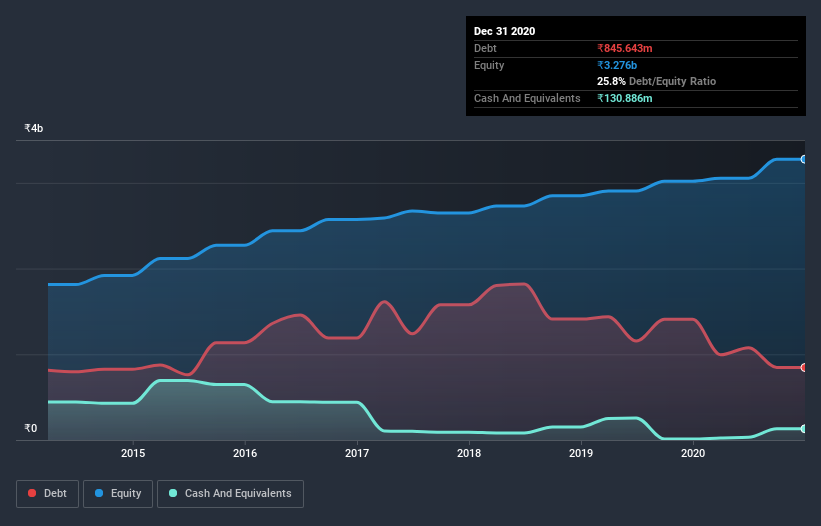
David Iben put it well when he said, 'Volatility is not a risk we care about. What we care about is avoiding the permanent loss of capital.' So it seems the smart money knows that debt - which is usually involved in bankruptcies - is a very important factor, when you assess how risky a company is. Importantly, Gulshan Polyols Limited (NSE:GULPOLY) does carry debt. But should shareholders be worried about its use of debt?
When Is Debt Dangerous?
Debt assists a business until the business has trouble paying it off, either with new capital or with free cash flow. Part and parcel of capitalism is the process of 'creative destruction' where failed businesses are mercilessly liquidated by their bankers. However, a more common (but still painful) scenario is that it has to raise new equity capital at a low price, thus permanently diluting shareholders. Having said that, the most common situation is where a company manages its debt reasonably well - and to its own advantage. When we think about a company's use of debt, we first look at cash and debt together.
View our latest analysis for Gulshan Polyols
What Is Gulshan Polyols's Net Debt?
The image below, which you can click on for greater detail, shows that Gulshan Polyols had debt of ₹828.1m at the end of September 2020, a reduction from ₹1.41b over a year. However, it also had ₹130.9m in cash, and so its net debt is ₹697.3m.

A Look At Gulshan Polyols' Liabilities
Zooming in on the latest balance sheet data, we can see that Gulshan Polyols had liabilities of ₹1.23b due within 12 months and liabilities of ₹207.7m due beyond that. Offsetting this, it had ₹130.9m in cash and ₹1.03b in receivables that were due within 12 months. So its liabilities outweigh the sum of its cash and (near-term) receivables by ₹282.3m.
Of course, Gulshan Polyols has a market capitalization of ₹4.36b, so these liabilities are probably manageable. However, we do think it is worth keeping an eye on its balance sheet strength, as it may change over time.
We measure a company's debt load relative to its earnings power by looking at its net debt divided by its earnings before interest, tax, depreciation, and amortization (EBITDA) and by calculating how easily its earnings before interest and tax (EBIT) cover its interest expense (interest cover). Thus we consider debt relative to earnings both with and without depreciation and amortization expenses.
Gulshan Polyols has a low net debt to EBITDA ratio of only 0.77. And its EBIT covers its interest expense a whopping 10.0 times over. So we're pretty relaxed about its super-conservative use of debt. In addition to that, we're happy to report that Gulshan Polyols has boosted its EBIT by 65%, thus reducing the spectre of future debt repayments. There's no doubt that we learn most about debt from the balance sheet. But you can't view debt in total isolation; since Gulshan Polyols will need earnings to service that debt. So when considering debt, it's definitely worth looking at the earnings trend. Click here for an interactive snapshot.
Finally, a business needs free cash flow to pay off debt; accounting profits just don't cut it. So we clearly need to look at whether that EBIT is leading to corresponding free cash flow. Over the most recent three years, Gulshan Polyols recorded free cash flow worth 54% of its EBIT, which is around normal, given free cash flow excludes interest and tax. This cold hard cash means it can reduce its debt when it wants to.
Our View
Happily, Gulshan Polyols's impressive EBIT growth rate implies it has the upper hand on its debt. And that's just the beginning of the good news since its interest cover is also very heartening. Zooming out, Gulshan Polyols seems to use debt quite reasonably; and that gets the nod from us. After all, sensible leverage can boost returns on equity. The balance sheet is clearly the area to focus on when you are analysing debt. But ultimately, every company can contain risks that exist outside of the balance sheet. For example, we've discovered 2 warning signs for Gulshan Polyols that you should be aware of before investing here.
Of course, if you're the type of investor who prefers buying stocks without the burden of debt, then don't hesitate to discover our exclusive list of net cash growth stocks, today.
When trading Gulshan Polyols or any other investment, use the platform considered by many to be the Professional's Gateway to the Worlds Market, Interactive Brokers. You get the lowest-cost* trading on stocks, options, futures, forex, bonds and funds worldwide from a single integrated account. Promoted
New: Manage All Your Stock Portfolios in One Place
We've created the ultimate portfolio companion for stock investors, and it's free.
• Connect an unlimited number of Portfolios and see your total in one currency
• Be alerted to new Warning Signs or Risks via email or mobile
• Track the Fair Value of your stocks
This article by Simply Wall St is general in nature. It does not constitute a recommendation to buy or sell any stock, and does not take account of your objectives, or your financial situation. We aim to bring you long-term focused analysis driven by fundamental data. Note that our analysis may not factor in the latest price-sensitive company announcements or qualitative material. Simply Wall St has no position in any stocks mentioned.
*Interactive Brokers Rated Lowest Cost Broker by StockBrokers.com Annual Online Review 2020
Have feedback on this article? Concerned about the content? Get in touch with us directly. Alternatively, email editorial-team (at) simplywallst.com.
About NSEI:GULPOLY
Gulshan Polyols
Engages in the mineral and grain processing, and ethanol distillery businesses in India and internationally.
Mediocre balance sheet with questionable track record.

